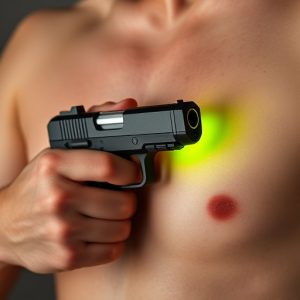Stun Gun Safety and Effective Use: A Comprehensive Guide
A stun gun can effectively disable an attacker by delivering a high-voltage shock that doesn't…….
A stun gun can effectively disable an attacker by delivering a high-voltage shock that doesn't necessarily require direct skin contact. Its effectiveness depends on proper usage, including handling its range and understanding how environmental factors like weather and clothing affect its conductivity. Safety is paramount when using a stun gun; users must avoid deploying it near water, on individuals with heart conditions, or in enclosed spaces to prevent the shock from intensifying. Legal use of a stun gun varies by location, so it's crucial to be well-informed about local laws. Stun guns should be considered a last resort after attempting non-violent de-escalation tactics. Regular maintenance and safe storage are essential for ensuring the device is ready and secure when needed. For those wondering "does a stun gun have to touch skin," it's important to know that while direct contact enhances its effectiveness, it can still be effective without it under certain conditions. Always prioritize safety, legal compliance, and proper handling for effective self-defense.
When considering personal safety devices, stun guns stand out as a non-lethal option for self-defense. To harness their effectiveness while ensuring safety and legality, it’s crucial to understand their proper application. This article delves into the nuances of stun gun use, addressing frequently asked questions like “Does a stun gun have to touch skin?” and offering a comprehensive technical guide for effective usage. Additionally, we explore best practices for handling and storing your stun gun to maintain its functionality and adhere to safety standards. With the right knowledge and precautions, you can confidently incorporate a stun gun into your self-defense strategy within the bounds of the law.
Understanding Stun Gun Safety: The Importance of Proper Application and Legal Considerations
When considering the safe and effective use of a stun gun, it’s crucial to understand both its proper application and the legal implications surrounding its deployment. A stun gun is a self-defense tool designed to incapacitate an assailant by delivering an electric shock. Contrary to some beliefs, a stun gun does not necessarily have to make contact with the skin to be effective; however, the efficiency of the device can vary depending on how it’s used. Users should be well-versed in the device’s operation, including its range and the factors affecting its conductivity, such as weather conditions or the subject’s attire.
Safety protocols must also account for the potential risks associated with electric shock devices. It’s imperative to avoid using a stun gun near water, on individuals with heart conditions, or in confined spaces where the device’s effects could be magnified. Additionally, users should always be aware of the legal restrictions governing stun guns in their jurisdiction. Laws can vary significantly from one location to another, dictating where and how a stun gun can be carried and used. Understanding these regulations is not just about adhering to the letter of the law but also about ensuring that the use of such a device is both lawful and ethical. Always prioritize de-escalation techniques first; consider a stun gun as a last resort in self-defense scenarios, ensuring compliance with all safety and legal guidelines.
Technical Guide to Using a Stun Gun Effectively: Does It Need Direct Contact with Skin?
When deploying a stun gun for self-defense, understanding its mechanics and effective usage is paramount for personal safety. A common query regarding stun guns is whether they need to make direct contact with the skin of an assailant to be effective. In most cases, for a stun gun to deliver its full incapacitating effect, it should indeed come into direct contact with the individual’s skin. The electrical current emitted by the device relies on this contact to pass through the muscles and nerves, causing a strong neuromuscular response that temporarily immobilizes the target. This is often referred to as an “electrical barrier,” which can be crossed only when the probes make direct contact with the skin. However, the effectiveness of the stun gun can also be influenced by factors such as the distance from the target and the presence of damp conditions or clothing that may reduce the current’s efficacy. Users should aim to minimize these barriers for optimal performance. It’s crucial to practice with a stun gun to familiarize oneself with its handling, range, and how different environmental conditions can impact its functionality. Additionally, understanding the device’s limitations and proper use can enhance safety for both the user and the potential threat. Always adhere to local laws and regulations when considering the use of a stun gun as a means of self-defense.
Best Practices for Handling and Storing Your Stun Gun for Optimal Safety and Efficiency
When incorporating a stun gun into your personal safety plan, it’s crucial to handle and store the device responsibly for optimal safety and efficiency. Proper handling begins with understanding that a stun gun does not necessarily need direct contact with the skin to be effective; it can incapacitate an assailant by delivering a high-voltage, low-amp electrical charge that disrupts muscle control. This fact underscores the importance of maintaining a safe distance from potential threats when deploying the device.
To ensure your stun gun is ready for use and stored securely, adhere to these best practices: Always keep the stun gun in good working condition by testing it regularly according to the manufacturer’s instructions. Ensure that the batteries are fully charged and that the contacts are clean and free of corrosion. Store the device in a cool, dry place, away from moisture and extreme temperatures, as these can affect its performance. Keep the stun gun out of reach of children and unauthorized individuals; secure it in a locked container or storage compartment designed for such purposes. By following these handling and storage guidelines, you can enhance both the safety and efficiency of your stun gun, providing peace of mind that it will function as intended when you need it most.


